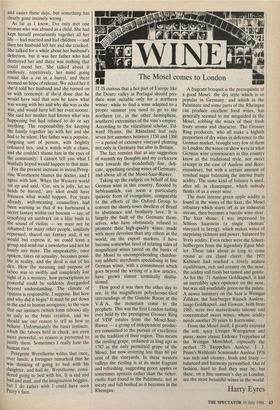The Mosel comes to London
IT IS curious that a hot part of Europe like the Douro valley in Portugal should pro- duce wine suitable only for a northern winter, while to find a wine adapted to a proper summer you need to go to the northern (or, in the other hemisphere, southern) extremities of the vine's empire. According to the viticultural scholar, Ed- ward Hyams, the Rhineland had only seven hot summers between 1150 and 1300 — a period of extensive vineyard planting not only in Germany but also in Britain.
The fact remains that at any suggestion of warmth my thoughts and my corkscrew turn towards the wonderfully fine, deli- cate, appetising riesling wines of Germany, and above all of the Mosel-Saar-Ruwer.
Taking up the cudgels on behalf of fine German wine in this country, flooded by liebfraumilch, can seem a particularly quixotic form of evangelism, comparable to the efforts of the Oxford Group to convert the shanty-town dwellers of Brazil to abstinence and brotherly love. It is largely the fault of the Germans them- selves, who have obstinately refused to promote their high-quality wines, made with more devotion than any others in the world, on the export markets. I have become somewhat tired of relating tales of magnificent wines tasted on the banks of the Mosel to uncomprehending chardon- nay addicts: merchants specialising in fine German wines, with a commitment which goes beyond the writing of a few articles, have grown almost terminally disillu- sioned.
How good it was then the other day to see, in the magnificent polychrome-tiled surroundings of the Gamble Room at the V & A, the mountain come to the prophets. This was the first London tasting ever held by the prestigious Grosser Ring of VDP estates from the Mosel-Saar- Ruwer — a group of independent produc- ers committed to the pursuit of excellence in the tradition of their region. This means the riesling grape, ordained as long ago as 1787 as the only permitted grape of the Mosel, but now covering less than 60 per cent of the vineyards. In these western valleys the riesling is at its most fragrant and refreshing, suggesting green apples or sometimes apricots rather than the richer, exotic fruit found in the Palatinate, not as meaty and full-bodied as it becomes in the Rheingau. A fragrant bouquet is the prerequisite of a good Mosel: the dry style which is so popular in Germany, and which in the Palatinate and some parts of the Rheingau can produce excellent food wines, has generally seemed to me misguided in the Mosel, robbing the wines of their fresh fruity aroma and character. The Grosser Ring producers, who all make a highish proportion of dry wines in deference to the German market, brought very few of them to London: the wines on show were in what German wine connoisseurs in this country know as the traditional style, not sweet (except in the case of Auslese and Beer- enauslese), but with a certain amount of residual sugar balancing the intense fruity acidity. The same kind of balance is used, after all, in champagne, which nobody thinks of as a sweet wine.
The most intense green apple acidity is found in the wines of the Saar, the Mosel tributary which starts off as an industrial stream, then becomes a bucolic wine river. The Saar shone: I was impressed by Schloss Saarstein (a single 'chateau' vineyard in Serrig), which makes wines of surprising richness and power, balanced by lively acidity. Even richer were the Scharz- hofbergers from the legendary Egon Mul- ler. These take about as long to come round as cru classe claret: the 1971 Kabinett had reached a lovely mature equilibrium, rich and creamy on the nose, the acidity still fresh but tamed and gentle. As for the '71 Auslese Goldkapsel, it had an incredibly spicy opulence on the nose, but was still youthfully green on the palate. A newer luminary on the Saar is Weingut Zilliken: the Saarburger Rausch Auslese, lange Goldkapsel, and Eiswein, both from 1985, were two marvellously intense and concentrated sweet wines, whose acidity needs another 20 years to harmonise.
From the Mosel itself, I greatly enjoyed the soft, spicy Urziger Wurzgarten and purer, more classic Erdener Treppchen of the Weingut Monchhof, especially the perfect '75 Treppchen Auslese. J. J. Prum's Wehlener Sonnenuhr Auslese 1976 was rich and creamy, fresh and lively balanced and harmony personified. Out of fashion, hard to find they may be, but these, on a fine summer's day in London, are the most beautiful wines in the world.
Harry Eyres


















































 Previous page
Previous page